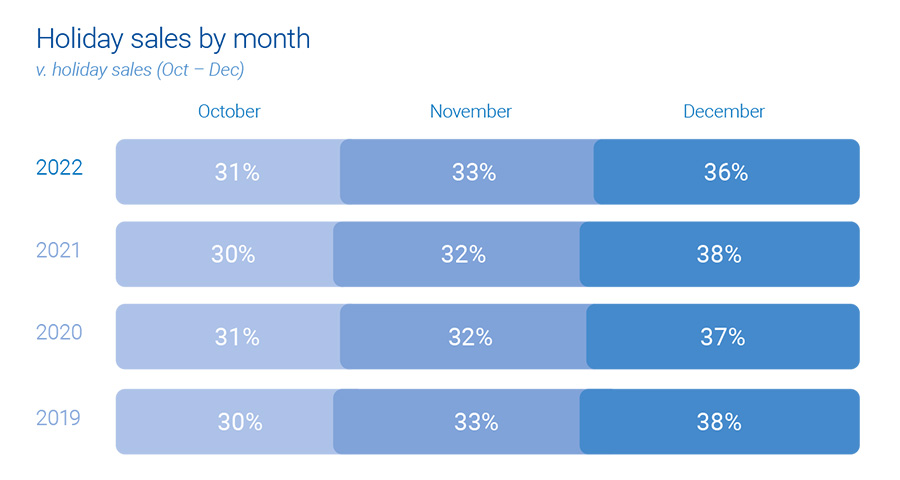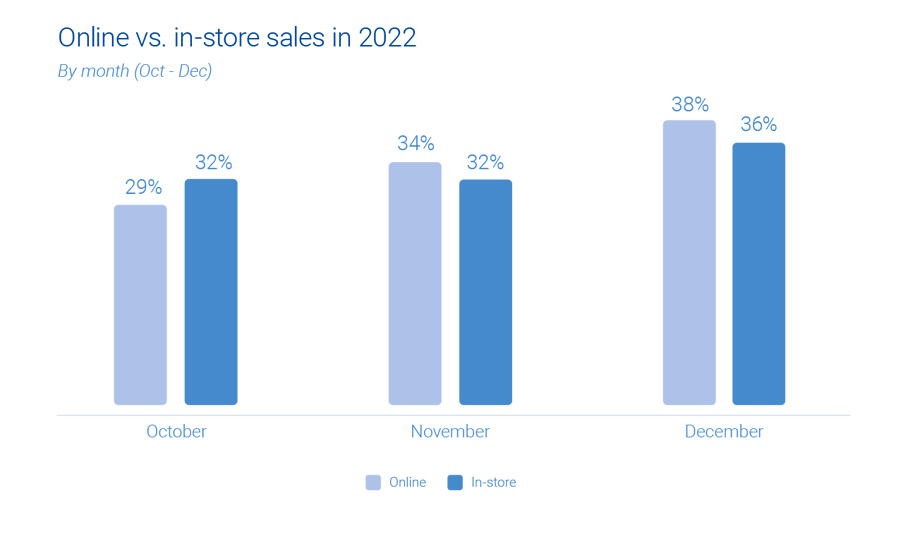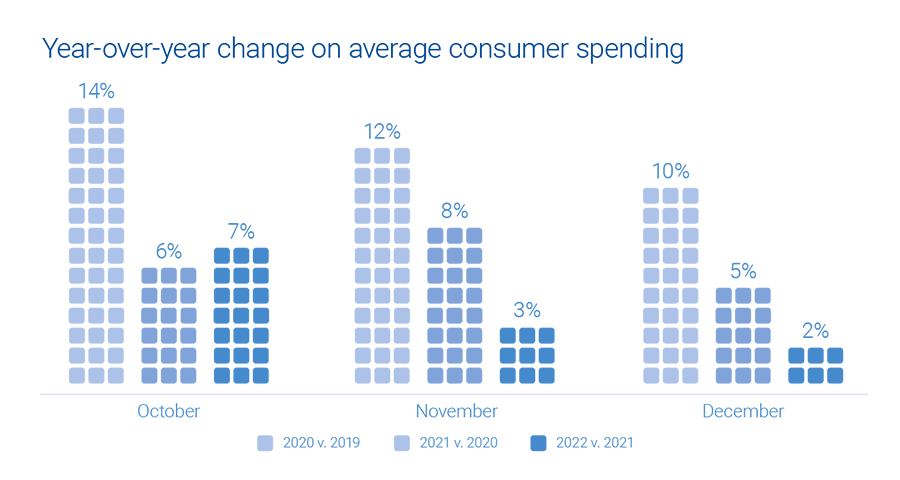
The holiday season is just around the corner, and retailers and marketers are gearing up for the busiest shopping period of the year. It’s crucial to understand how consumer behavior is evolving and what emerging trends to expect. Experian’s 2023 Holiday spending trends and insights report analyzes recent trends, consumer spending habits, and anticipates what’s to come in 2023 to help you deliver a top-notch shopping experience this holiday season.
In this blog post, we’ll cover three key insights from our report.
1. Consumers are shopping earlier
It’s no secret that December has always been the go-to month for consumers when it comes to holiday spending. However, holiday shopping now starts earlier, particularly with online sales.

This can be attributed to a surge in promotions and deals, enticing shoppers to open their wallets ahead of time, giving a significant boost to holiday sales. Notably, Cyber Week sales have proven to be an influential factor, accounting for 8% of total consumer holiday spending.
Experian tip
Reach the right shoppers with your promotions with sell-side targeting. This powerful approach gives you control over where your ads are placed while ensuring maximum visibility through direct connections with publishers. Whether on mobile, web, or CTV, this seamless ad experience will engage your audience effectively.
2. Online sales are on the rise
The popularity of online holiday sales is continuously growing, surpassing in-store shopping. There has been a consistent 1% year-over-year increase in online sales, while in-store sales have seen a 1% decrease.
“It’s easier for consumers to comparison shop for large ticket items online that they might find at a mass retailer or office supply store. Consumers prefer to have larger, bulkier items shipped directly to their home for minimal cost. By shopping online, consumers can save time since they don’t need to wait in checkout lines.”
Anna Liparoto, Sr. Account Executive, Retail & CPG

Although online sales currently make up only one-third of all holiday shopping, there is immense potential for further expansion. Mass retailers and office, electronics, and games industries particularly excel in online holiday sales. While in-store purchases remain the primary choice for holiday shoppers, consumer online and offline activities intersect before the final purchase.
Experian tip
Take advantage of the surge in online shopping by diversifying your marketing channels. An agnostic identity graph can bring together device and media data, capturing valuable user insights. By gaining a holistic view of your target audience, you’ll be able to optimize your ad spend and allocate resources effectively, ultimately boosting your return on investment.
“Omnichannel targeting during the upcoming holiday season will continue to prove to be the best way to reach scale and maximize ROI across all marketing channels.”
Joe LigÉ, Head of Enterprise Demand Partnerships
3. 2023 holiday spending will be on par with 2022
During the holiday season in 2022, consumer spending showed an anticipated increase, although the growth rate was slightly lower compared to previous years. October saw a surge in average consumer spending, indicating a swift response to early discounts and promotions offered by retailers.

As the holiday season progressed, holiday spending gradually slowed down and reached a level similar to that of the previous year. Overall, there was a modest 2% growth. Looking into the future, if economic conditions remain stable in the second half of 2023, we can expect holiday spending to align with the figures from last year.
Experian tip
To truly maximize impact, consider data enrichment. By diving deeper into your target audience’s preferences and behaviors, you can better tailor your strategies and seamlessly integrate the enriched data across various channels. This allows you to unlock the true potential of your ad inventory, creating more meaningful connections with your audience.
Download our 2024 report
Get ready for the holiday shopping season with Experian’s 2024 Holiday spending trends and insights report. Inside you’ll find:
- Analysis of past trends and what they mean for 2024
- Exclusive predictions for the upcoming holiday season
- The top audiences to activate this holiday season
To access to all of our predictions for this year’s holiday shopping season, download our 2024 Holiday spending trends and insights report today.
Latest posts

As part of our ongoing series which focuses on consumer and marketing trends around major holidays throughout the year, we’ve just released the Father’s Day Hot Sheet. Father’s Day gift-related searches Now that Mother’s Day has come and gone, consumers will be shifting their focus to dad. According to Experian Marketing Services’ Hitwise® online intelligence tool, searches for “Father’s Day” typically start to pop up on Mother’s Day. And searches for “Father’s Day gifts” tend to focus on affordable gift ideas that are personalized, unique and often handmade. In fact, two of the top variations of Father’s Day gift-related searches from 2014 were for “DIY” and “homemade” gifts. While many shoppers wanted the “best” gift for dad, others simply wanted something “cheap” or “last minute.” Finding a gift that dad will appreciate means looking for something that is personalized to him. As such, searches for Father’s Day gifts often contain additional information about the dad or, in many cases, grandpa. Examples commonly used in 2014 were “Christian dad,” “new dads,” “outdoorsy dads” as well dads who are wine or BBQ lovers. While many gift searches include information about the intended recipient, others mention details about the gift-giver or their relationship to the father. Among last year’s variations that included such details, nearly a third focused on gifts that were intended to be given by a “daughter.” Genderless references, such as “kids” or “children” were almost as common. Interestingly, fewer than ten percent were for gifts to be given by a “son.” About a fifth of searches included details about the age of the gift-giver (e.g.: “baby,” “toddler” or “first grader”), while others specified that the gift was to be given by the dad’s wife or girlfriend. Go, go, gadget dad! Gadgets and gizmos are always popular gifts for the techie dad. In fact, during the week immediately preceding Father’s Day last year, visits to Electronics and Appliance websites were up a relative eight percent from two weeks prior. Visits subsequently tapered off the following week. An analysis of search terms driving traffic to the Hitwise Electronics and Appliance industry the week ending June 14 versus May 13, 2014 also sheds some light on the specific items that Father’s Day gift-givers were likely to have been seeking out. Two GPS systems (“Magellan GPS” and “Tom Tom”) were among the top terms that grew search share in the weeks leading into Father’s Day last year. Likewise, “GoPro” appeared in two separate fast growing search terms. Gadgets like these and others listed in the adjacent table may be big gifts for the gadget-loving dad again this year. Gone fishin’ Fishing is a timeless family pastime enjoyed by millions of Americans. According to Experian Marketing Services’ Simmons® National Consumer Study, 28 percent of dads and 26 percent of kids ages six to 17 went fishing last year. As such, it’s no surprise that online searches related to fishing spike over Father’s Day weekend. On the Saturday before Father’s Day in 2014, searches including “fishing” were a relative 28 percent higher than they were the Saturday prior and 64 percent higher than they were the following Saturday. To better understand what kids and dads were seeking out for their fishing plans, Experian Marketing Services conducted an analysis comparing variations of “fishing” searches immediately before Father’s Day last year to those performed two weeks prior. It turns out the word “techniques” was almost 8.6 times more likely to appear in fishing-related searches just before Father’s Day than it was two weeks earlier and “tips” was four times more likely to be used. Likewise, “licenses” was used 2.3 times more frequently, which along with the higher use of “techniques” and “tips” is evidence that many would-be fishermen and women are occasional participants at best. The fact that “charter” and “cabins” were used at higher rates however suggests that other children and/or dads had something in mind beyond a lazy (and likely more affordable) afternoon at the local fishing hole. Gift items, too, like “reels,” “gear” and “tackle” were among those most disproportionately used in searches heading into Father’s Day.

Welcome! Who doesn’t like a warm welcome? Whether your customer is walking into your store or just signed up on your website to receive communications from you, she expects a warm reception. It’s important to make that first impression count. A welcome series helps the conversation open up between the customer and your brand. It sets expectations on the types and cadence of content the customer will receive. Welcome emails also garner 86 percent higher open rates than regular promotional mailings – not too shabby! In a recent webinar, Saks Fifth Avenue shared that they are constantly testing new and current programs to optimize the customer experience. As a result, they discovered that switching from batch-sending welcome emails to sending welcome messages in real time increased open, click and redemption rates significantly. Here’s an example of their welcome series: Saks’ results are consistent with Experian Marketing Services’ welcome email findings which indicate that emails triggered in real time receive up to 10 times the transaction rates and revenue per email vs. those that are batched. A welcome series has also been shown to increase retention by educating customers on new ways to use products and services they’ve purchased from your brand. These emails also can remind customers of the benefits they’ll reap from enrolling in your loyalty programs or credit card. … and welcome back Even if a customer has been welcomed and has interacted with your programs, a day may come when the customer goes silent. Reactivation campaigns are an effective way to get them to re-engage. Naturally, it’s important to target your dormant customers in a variety of channels so you can reach them more effectively. Maybe you’re wondering why I jumped from the warmth of a welcome series right into reality of needing a reactivation campaign. The reason? Marketers need to understand where a customer is in their lifecycle and come full circle with customers if they have parted ways. Marketers can pique the interest of a returning customer by telling them what’s new and reintroducing them to their brand. Carnival® Cruise Lines, for example, sends a welcome-back email that features the newest social networks, offers and deals its customers can take advantage of immediately. At the end of the day, customers expect to receive relevant and engaging messages throughout their entire relationship with a brand. Customer life cycle programs deliver just that. If you’re interested in learning more about welcome campaigns, waitlist/back-in-stock programs and other remarketing strategies, check out our webcast,

In a previous blog entry, Ordering sushi and a lesson in embracing the contextual marketing mindset, I showcased a fictitious scenario that required complex data point integration to pull off. These kinds of programs can seem overwhelming given the three barriers that many organizations face when embarking on their contextual marketing journey: Marketing sophistication A brand’s own conventional mindset and the programs that support it Actionable data Lack of clean and accurate data that prohibits real-time “on the fly” interactions Technology Disparate systems that are unable to link information across repositories, channels and interactions; inability to automate interactions in real-time Regardless of the barriers, there are ways you can show customers you’re listening and provide contextual messages without “boiling the ocean.” Take, for example, the recent viral blue/black vs white/gold dress debate. As the conversation spread throughout Facebook and Twitter, brands like Dunkin’ Donuts and Tide tweeted these contextual messages: The tweets did not go unnoticed as thousands of followers retweeted, commented and favorited these messages. The contextual elements used in these messages — channel preference and breaking/relevant news — are easily accessible to any brand. While the brands had to act swiftly, executing these messages circumvented the three barriers listed above. On the flip side, addressing the barriers can allow a brand to build more sophisticated, targeted contextual messages, as shown in the below example. Here, Experian Marketing Services and technology partner Movable Ink helped Finish Line deliver this sale announcement that adjusts based on the date and time the customer opens the email. The message remains relevant via a countdown clock during the run of the sale, a “warning” when it’s about to end and an alternative message after the sale ends — all of which ensures that the message is relevant regardless of when it’s opened by its intended recipient. And combining more contextual data points, such as location and stock, Finish Line includes the countdown, a local map to the customer’s nearest location and up-to-the-minute inventory of available sizes. Contextual marketing enables modern enterprises to engage in customer-centric conversations that — like any meaningful relationship — deepen across time and future points of engagement. This is particularly true in an era when consumers are overwhelmed by untargeted and disruptive marketing messages. By contrast, contextual marketing is designed to seamlessly and usefully merge into the customer’s daily activity. Want to know more and how to get started? Download the eBook From campaigns to context: Making the move to contextual marketing.